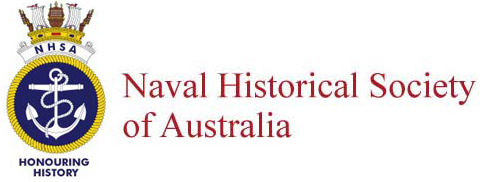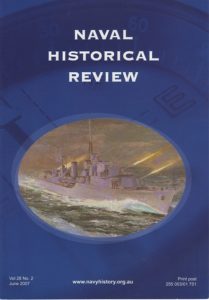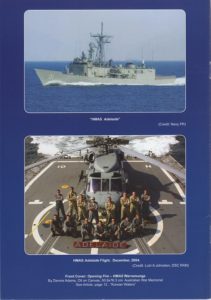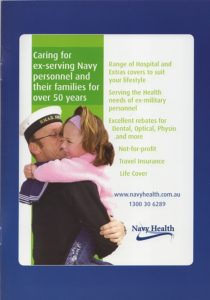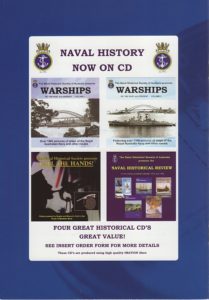By Steve Chaplin, former RAN Leading Seaman Weapons Mechanic (LSWM)
What could be more calming and restful, other than relaxing and taking in the serene ice blue, flat calm waters of the Indian Ocean, on a pleasant sunset cruise in Australia’s tropical northern waters? Well, the only thing missing of course was a chilled icy cold beer, some delicious nibbles and the company of good friends to share in this spectacle.
My reverie was quickly snapped back into reality by the nauseating odours of reeking fish and unwashed and repugnant body odours assaulting my nostrils – all this combined and viewed onboard a 35 metre Taiwanese fishing boat in May of 1973.
Intermingling in all this, was the mouth-watering scents of cooking odours wafting across the decks to return memories of times past during my visits to the Orient and dining out in some pretty amazing restaurants and street cafes. Sadly though, the reality at that exact time was experiencing rats the size of cats and masses of ugly, sizeable cockroaches scurrying around the decks and throughout the vessel that made one’s skin crawl.
One could ask the question – what on earth would make you want to take a cruise onboard a Taiwanese fishing boat….well here is why.
Attack Class Patrol Boat – History
The Royal Australian Navy (RAN) have been operating patrol boats/patrol vessels since World War 2 but in the years following cessation of hostilities, our patrol boats became actively engaged in the dynamic role of the prevention of illegal immigration/people smuggling, illegal fishing, drug running, quarantine and trafficking.
It wasn’t until 1963 that the RAN began to seriously initiate the feasibility study for a new boat of simple features, approximately 25 metres (80 feet) long, speed of 12 knots or more, with berthing for a minimum of 14 crew (Officers & Ships Company).
With the final design features complete by naval architects from the Department of Navy, these Patrol Boats would be referred to as “Attack Class” and would carry out general duties, harbour defence, pursuit and interception duties.
The final design notified the following details:
| SPECIFICATION | DETAILS |
| Length | 32.8 Metres (108 ft) |
| Draught | 2.2 Metres (7 ft) |
| Beam | 6.1 Metres (20 ft) |
| Displacement | 148.3 Tonnes |
| Engines | Two Paxman V16 Ventura turbo-charged diesels 2611 kW, twin screws |
| Speed | 24 Knots (Max) 15 Knots (Cruise) |
| Complement | 19 (3 Officers, 16 Sailors) |
| Endurance | 1,500 NM (Approx) @ 15 Knots
Water & Victuals: 14 Days (Approx) |
All twenty Attack class boats were built in Queensland (Australia) by two engineering works at around $A800,000 per boat (1965 prices);
- Evans Deakin Brisbane 13 boats built, and
- Walkers Ltd Maryborough 7 boats built
The first of the Attack class boats was launched on the 08th April, 1967 and was commissioned as HMAS Attack(P90). HMAS Attack was decommissioned on the 21st February, 1985.
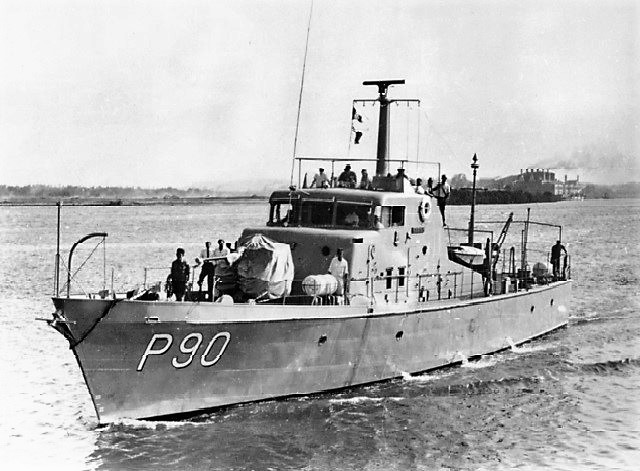
All Attack class patrol boats delivered remarkable service throughout their service life of more than two decades in the RAN, with the last boat, HMAS Aware (P91) being decommissioned on the 17th July, 1993, having served 25 years in service life.
Illegal Fishing Activities
As far back as seafaring history informs us, Australia’s territorial waters have offered fishermen generous and guaranteed hauls/catches in multitudes of fish/marine species. This fishing, performed by a number of Australia’s northern international neighbours encroaching into our territorial waters, was having a somewhat overwhelming effect on our own fishing businesses in the late 1960’s and early 1970’s.
At this particular time, Australia did not have a declared fishing zone and this was not initiated until 1979.It was referred to as the 200 nautical mile Australian Fishing Zone (AFZ).
In 1974 traditional Indonesian vessels were allowed access to a defined area of the Australian fishing zone (north-west of Broome) in which Australia agreed not to enforce its fisheries laws – an area known as the Memorandum of Understanding (MoU) Box.
RANR Training Cruise – May 1973
HMAS Acute (P81) was scheduled to undertake a 13-day training cruise beginning on the morning of Saturday 28thMay, 1973 under the command of LCDR. R.P. (Pat) Rodriguez RANR, with a full complement, that included 5 Permanent Naval Force (PNF) personnel from HMAS Leeuwin to make up the crew.
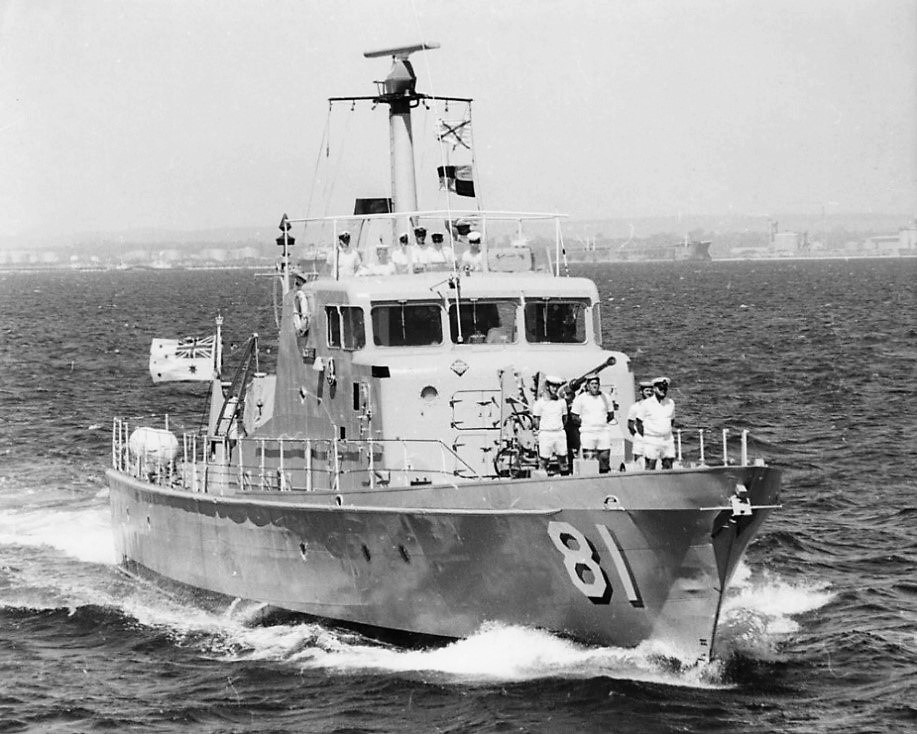
Acute got underway at 1300 hrs from Fremantle, for the northern seaside city of Geraldton and made good passage overnight assisted by favourable weather and arrived on the Sunday morning to refuel.
On completion of fuelling, Acute shaped course again for the north and conducted small arms shooting, Officer of the Watch (OOW), ship handling and navigation exercises in and around the Shark Bay area.
Acute arrived on the morning of, Tuesday 1st May, 1973 alongside the Naval Pier, Point Murat, North West Cape having enjoyed a smooth overnight passage from Shark Bay. The ship remained in the area for 2 days conducting static and operational displays of the vessel, viewed by embarked members from the U.S. Naval communications base, Harold E Holt.
On the evening of Wednesday 2 May a signal was received for the ship to sail to Dampier in order to embark a Department of Primary Industries (DPI) officer in order to investigate foreign fishing vessels alleged to be operating in a Declared Fishing Zone (DFZ) in the region of the Monte Bello Islands.
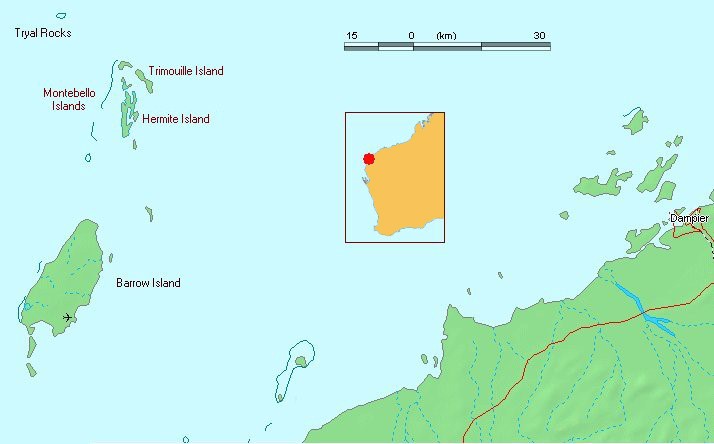
Acute arrived at the Dampier service wharf on Thursday morning at 1100 to embark the officer from DPI and on completion of refuelling, sailed for the Monte Bello Islands. Weather at this time was calm with a very light breeze.
The ship, at pursuit speed arrived in the reported location 25 minutes after sunset and sighted 2 vessels actively trawling with and both vessels being taken by complete surprise. The vessels were identified as the Chiah Long No. 11, and Chiah Long No. 12
The vessels recovered their trawls and a boarding party of 5 personnel (including the DPI officer) was despatched to the Chiah Long 11, however engine failures of 2 outboard motors delayed the boarding of the vessel by some 50 frustrating minutes.
After a thorough search of both vessels was completed by the boarding parties, both vessels were detached and headed for Exmouth at approx 2100 hrs. Acute resumed her patrol in search of other reported illegal fishing vessels.
Unfortunately, radar problems dogged Acute but a further 2 vessels were sighted at around midnight and estimated to be trawling 2.2 miles inside the DFZ. These vessels were identified as Yeon Lim No. 1, and Yeon Lim No. 2.
Both vessels were instructed to stop and both vessels recovered their respective trawls. However, one of the fishing vessels altered course to the North and attempted to run.
Acute gave chase and after illuminating their 50cal machine gun with a searchlight, the trawler immediately stopped. The .50cal machine gun, incidentally, was not loaded – more of a show of force – which unquestionably worked!
During the boarding interrogation from the officer from DPI, the Captain of the trawler was very hostile and un-cooperative as well as being somewhat argumentative. Given the continued electrical malfunction and failing of Acute’s radar, it could not be conclusively proven that the fishing vessels were in fact inside Australia’s DFZ and a decision was made to officially warn the trawler Captain that any further incursion would lead to him and his crew being arrested.
The other downside to the apprehension of the second pair of trawlers was, HMAS Acute was already short 5 crew as they were involved in the arrest of the earlier vessels and on their way into Exmouth. Coupled to this, the weather was rapidly deteriorating and within an hour, it was blowing at Force 5, making her passage back to Exmouth very uncomfortable and extremely demanding for the crew.
During the night as Acute steamed for Learmonth, she encountered very unpleasant weather and didn’t sight or encounter the other two vessels during her transit and arrived at her anchorage on the afternoon of Friday 4th May at approximately 1400hrs. Acute then received information that the two arrested ships had been located by Coastwach aircraft in the region of North West Cape, proceeding at slow speed. They duly arrived at anchorage close to Acute at 1730. Once secured, the boarding party was replaced by other members of Acutes crew in order to provide an opportunity for a decent meal, shower and much needed rest.
PNF Back-up Assistance
Given the circumstances which were quickly unfolding at the time, support from additional personnel was requested not only to assist with guard duties onboard the fishing vessels, but also, to replace a number of RANR personnel who needed to return to Perth to report back for their normal civilian employment obligations.
On Friday 4th May, myself and five other members of HMAS Leeuwin Ships Company were flown by commercial flight from Perth to assist in support operations. We arrived in Learmonth around midday and then transported to the RAAF Base for accommodation and to be further briefed as to what role we would be required to undertake in the guarding and support of the Taiwanese fishing vessels.
All vessels remained at anchor in Learmonth over the course of the next three days, bearing in mind it was a weekend and a majority of Government agencies were closed down during this period. It wasn’t until early afternoon of Tuesday 8th May, that the Crown Prosecutor plus an interpreter were available to initially gather the facts and documents relating to the arrest of the vessels and conduct a hearing.
Rotational guard duties on both fishing vessels continued in this time and during our “off “ watch, we (PNF personnel) were still accommodated at the RAAF base for meals and sleeping quarters and at that particular time we weren’t to know how luxurious these benefits were !
A decision was reached to have both Captains of the fishing vessels charged on Wednesday 9th May in the Exmouth Court House and then adjourn until the case could be heard in the Geraldton Court. On the Wednesday morning, both of the fishing vessels Captains were taken ashore to be officially charged and under instructions, the security detachments assigned to the fishing vessels would oversee the crew to weigh anchor and set course for Geraldton. Acute would follow once the legal proceedings were complete.
The arrested vessels weighed anchor at 0730 hrs under charge of two RANR Officers – one on each vessel, supported by two PNF personnel. I was embarked aboard the Chiah Long 11, along with POQMG “Bob” Dodd, with Leading Seaman “Paddy” Gascoigne and Able Seaman “Bob” Jeffries on the Chiah Long 12. What a fine crew we were.
Considering these fishing vessels could only make good 8 knots, we knew it wouldn’t take too long for the Acute to catch us up once all of the legal proceedings ashore were completed. The sea during our initial departure and trip was typical of a mirror – flat calm and very balmy weather and we were making good time – all things considered.
During our observations over the weekend during our guard duties, we all collectively agreed that we wouldn’t eat anything at all off the fishing vessels. Given what we witnessed and smelt inside the vessel – rats and cockroaches, we were provided with sufficient provisions to get us through to Geraldton without running the risk of getting food poisoning or gastroenteritis.
Acute duly caught up with us around 1730 hrs that afternoon (Wednesday 9th May) and we then had the respective Captains of each vessel transferred back onboard. Continuing South we experienced varying sea conditions with winds and seas mainly from the North West, accompanied by a large swell.
Of note, HMAS Acute’s minimum cruising speed was 12 knots and that was on one engine, therefore she had to continually backtrack to remain in contact with both arrested vessels, even with quartering speeds lifting the fishing vessels speed to 9 knots. This resulted in a faster passage than anticipated into the Port of Geraldton, arriving on Friday 11th May at around 1700 hrs.
Upon arrival Geraldton, it wasn’t too long before we were advised that due to a number of significant legalities related to the arresting and conviction of the two fishing vessels, Geraldton was unable to process the proceedings any further, therefore, it was off to Fremantle we go – Oh, how wonderful – we get some more “sea time” up!
Both fishing vessels were then refuelled with approx. 2,275 litres each of diesel fuel, filling their respective fuel bunkers to maximum capacity. From our “best” estimated calculations, Bob Dodd and I believed the boats fuel tank/s could hold around 6,000 litres, which is of course why there was always a ‘mother” ship accompanying these boats in support of their fishing activities.
So – just to add more grist to the mill, at about that time, the Captain of the Chiah Long 11 decided to throw a spanner in the works and claim that the propellor shaft bearings were overheating, due to a bend in the propellor and he would only manage a speed of some 4 knots. With this news and bearing in mind the time (early evening), the services of a diver were required to investigate the allegations of a bent propellor.
In due course a diver was engaged to perform an inspection and report on the state of the propellor and the diver reported that of the four (4) blades, three (3) of the blades had bends in them – approx. 255mm long and with one (1) blade missing a small section. The diver’s opinion was that the vessel could still make speed up to 8 knots and be capable of completing the trip to Fremantle. Furthermore, the Chief Engineer from HMAS Acute inspected the propellor shaft and also expressed confirmation that the vessel would be capable of steaming at 8 knots without occasioning major or significant damage.
During our interval in Geraldton, an additional four (4) PNF relief personnel arrived by bus to replace a number of the RANR crew who had to be back in Perth by Saturday 12th May and in this time, we, the crews in the fishing boats reprovisioned for the forthcoming last leg of the passage to Fremantle.
We were all asked if we wanted to change around onto Acute for some respite off the fishing boats, but to a one, we all declined – and why, you ask would one wish to remain onboard a smelly Taiwanese fishing boat – simple – they had exceptional sea keeping qualities and were not being bashed or thumped around in heavy seas – they rode very comfortably – their only redeeming feature, sadly.
With all formalities completed, all three of us sailed for Fremantle at around midnight on the Friday night (11th May) with a falling glass, indicating we were heading into some uncomfortable weather. By Sunrise on the Saturday (12thMay) morning, we encountered heavy rain squalls and rising winds. Observing Acute in those conditions, Petty Officer Bob Dodd and I agreed we felt we had made the correct decision by remaining aboard the Chiah Long 11 as we were comfortably riding the swells without uneasiness.
By late afternoon Saturday, circumstances had deteriorated significantly and sea conditions were extremely rough – we estimated a Force 5. This was evident when Acute in her requirement to backtrack to maintain contact with us, experienced significant unsettling weather across her decks from seas pounding onto her from the North West and some time around midnight, her starboard life raft was ripped away from the stowage brackets and washed overboard, but with a sea state of in the region of Force 6 and so rough, a recovery was considered far too dangerous.
Continuing on, the three of us, all duly arrived in Fremantle Port and berthed at approx. 0100 hrs Sunday 13th May, somewhat weather beaten, tired, hungry and desperately in need of a shower, having completed a marathon 1,000 plus, nautical mile passage from point of interception. What of course was warmly received, was a steaming hot mug of soup provided by our berthing party – very much appreciated, let me tell you. Formalities complete, it was back to HMAS Leeuwin and much needed sleep.
Matters Of Interest
- During the transit from Exmouth to Fremantle, we only allowed the Captain and one helmsman onto the Bridge at any one time. This ensured our safety should any member of the crew attempt to interfere or take over the vessel, plus it allowed one of us to have sleep every few hours or as need be. During this time, I investigated a significant number of charts located in drawers discovered under the Captain’s bunk and was alarmed at what was found. Enormous 100 nautical square mile blocks had been marked out on charts of WA’s North West coast showing their obvious areas of operations, but of more significance, was a large percentage of the blocks had big crosses in them, from which we deduced these had been previously fished in. These charts were surrendered to our senior officer upon arrival in Fremantle, which would hopefully assist in the prosecution of the alleged fishing operations.
- Although the boats themselves were considered (by European standards) smelly, dirty and unkempt, they were well equipped for their intended purpose – fishing. a.nTheir radio and navigation kit appeared to be surplus U.S. equipment (possibly from WWII), but still providing adequate operational support. The crew accommodation, other facilities and interior outfit of these vessels was obviously not considered important as most features were of sub-standard quality and very poorly maintained. Fridges/freezers and engineering was of a somewhat more enhanced fit out, but having said that, were sadly lacking in any form of planned maintenance procedures (oil and water leaks etc).
- Living conditions on the vessel did not encourage the sharing of meals with the crew. However, the mouth-watering odours of Asian cooking floating into the confines of the bridge certainly had Bob and I salivating at meal times. However, when reality kicked in and one viewed the conditions under which the meals were prepared, cooked and eaten, one decided perhaps our hard tack provisions weren’t so bad after all.
- For a little bit of light relief, the “heads” onboard certainly reminded one that you were really on a Taiwanese fishing boat. The boat builders when constructing the vessel didn’t consider having a “head” onboard a major requirement, plus it was probably considered a cost saving which could then be spent on additional fishing equipment. The “head” was located on the Starboard side right on the stern of the vessel and when looked at, you could be correct in believing it resembled an Australian outdoor dunny from a country farm in the 1950’s. However, upon entering said “head” your very first instinct was to immediately locate and grab in sheer terror, something solid to hang onto, because gazing down, you were looking directly at the open ocean washing out from under the stern of the vessel. To assist in the requirement of “sitting” was a rough, dirty and excrement covered plank of wood. Needless to say, Bob and I both were grateful for our vessel’s arrival in Geraldton and Fremantle.
- Reports indicate that the Chiah Long 11 caught fire and foundered near Yap Island in the Western Section of the Caroline Islands on the 26th April, 1989. Nothing is known of the Chiah Long 12.
